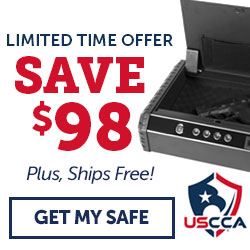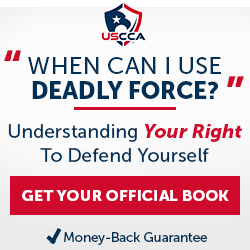What You Need To Know
- ✔ U.L. Class safes are more expensive
- ✔ Fire certified and fireproof does not mean truly fireproof
- ✔ Be careful of safes with a U.L. marking pertaining only to the lock of the safe if you're looking for fireproof
You start out with one gun, then two, three, four, and before you know it, you have a small armory. Whether your collection consists of hunting rifles, shotguns, handguns or you’re just collecting antique firearms, you’ll probably come to a point where purchasing a gun safe is on your to-do list. Luckily, there are plenty of options out there based on looks, locks, size, capacity, etc. So, depending on what you’re looking for will determine what works best for you. And to help get you started in the right direction, here are some of the best gun safes. But first, a little history.

History of the Gun Safe
Before we get into all the cool gun safe options—believe us, there are some awesome ones out there, like the kind you can hide in your wall, the steps, under your coffee table—we thought it might be interesting to give you a glance into where the gun safe got its start. Of course, this could be a long history lesson, so we’ll keep it to steel, gun safe type information, unless of course, you want to start with the Egyptians…but we don’t.
Instead, we’ll start with the pirates—you know the ones hunting for buried treasure. Seriously though, sailor merchants should be given some credit as to the start of the idea of safes. No, we aren’t talking gun safes exactly. But, they did have chests with banded steel requiring a key to unlock it.
In the 1820s a man by the name of Jesse Delano took the sailors’ idea one step further with fireproofing a wooden foundation, like that of the ‘treasure chest.’ C. J. Gayler went even further in 1833 and patented a ‘double chest’ version of a fireproof safe.
However, it wasn’t until 1850 when fireproofing would finally reach its most effective method yet, the method we use today. In fact, hydrated plaster—what’s commonly used in safes—was put to the test in a competition. During the competition, a man by the name of Silas C. Herring designed a safe and then laid it in a fire for 40 hours. In the end, all the contents were said to be undamaged. However, it wasn’t until 1917 when the first standardized test for fireproof safes would come out.
Of course, fireproof safes aren’t the only thing you’re looking for when it comes to locking up your goodies. They also have to be theft-proof. Charles Chubb can be credited for the first burglar-proof safe, which he patented in 1835, not long after Gayler’s ‘double chest’ safe.
How Gun Safes are Made
Delano’s safe was made of wood, clay, lime, and steel. After 1830, safes were made from stone, wood, cement, plaster, mica, alum, chalk, clay, and even asbestos or dead-air space. Herring’s safe was made of steel and plaster.
Today’s safes are typically made with double-walled steel and filled with either plaster or cement (if they are fireproof). Basically, they aren’t light, and unless you can break into one, you aren’t going to be picking it up and loading it into the back of a pick-up truck for a quick get-away. So, fireproof aside, the locks and weight (depending on size) alone guard against theft of your precious toys.
However, many gun safes aren’t made to Herring’s fireproof standards. Instead of using heavy steel on the outside and light steel on the inside, filled with concrete, gun safes today are filled with drywall and surrounded by a light gauge steel and carpeting. Last we checked, carpet isn’t fireproof, and neither is drywall—if the fire is hot enough, which in most cases you won’t see, but still, that means your safe is fire resistant, not fireproof.
In fact, unless your safe has a UL-Class 72 350-X marking, it is not fireproof. “Fire tested” and “fire certified” are not the same thing. They may hold up to a certain level of heat, but they won’t last and aren’t guaranteed to survive the life of a fire. Some safes will list a UL rating, but not all UL ratings mean the entire safe is fireproof, it might just be referring to the lock, so read the fine print.
Our Gun Safe Rating Standards
One of the biggest complaints out there is that many gun safes either don’t accommodate the new shapes and sizes of guns or they don’t account for accessories. Some of our recommendations do consider these, with that said, here’s how we rate gun safes
Accommodations
Not every weapon is the same, and not every gun owner buys the same sized rifle, shotgun, or pistol. Therefore, most of us want a safe that not only protects our toys from thieves but also stores them properly by accommodating a vast selection of firearms.
Fireproof/Theft-Proof
There’s a difference between fireproof and theft-proof safes. All theft-proof safes aren’t fireproof, and all fireproof safes aren’t anti-theft. With that being said, we like our safes to include both protection qualities; therefore, several of our recommendations are based on these two things.
Cost/Quality
Cost isn’t always everything, meaning sometimes you’re only paying for a name and not quality. Of course, depending on how much room you need and any specifics, you will pay more. However, that doesn’t mean you need to pay a year’s worth of mortgage payments for a quality gun safe. Unfortunately, heavier and more expensive does not always mean more protection.
Top-Shelf Gun Safes
U.L. Class TL-30 gun safes are some of the most expensive safes on the market because they can withstand much more heat at an extended period of time than the less costly options. With that being said, the below safes are not the cheapest on our list, but they are intended to hold-up to a house fire. You can find more cost-effective versions elsewhere, but there’s a very good chance the safe and everything in it will burn before the fire department can put out the fire.
American Security, shown above, is actually on the cheaper side as far as safes of this size and class go. You could spend well over $15,000 on a U.L. Class TL-30 safe. But, the safe above will cost half that, $7,500.
The Browning U.L. Class TL-30 safe isn’t the most expensive option on the market, but that doesn’t mean it won’t cost you. We like this particular safe because you can build it to your standards. Basic customization starts out at $9,500.
Best Large-Scale Gun Safes
Who doesn’t have the dream of owning their own armory? Of course, if this is you, you’ve already spent some money, and you’ll have to pay more if you want to protect them. A small one or two rifle safe just won’t work, so you’ll need a larger safe.
The particular safe shown above is great if you want a little control over your storage space. You have the option of removing the shelving unit to take full advantage of the 45 rifles slots. However, this safe will only stand up to 1,200 ºF for one hour. It also weighs 667 lbs. and will cost you $1,660.
Maybe you have a much smaller gun collection and don’t need a safe that holds 45 rifles. If so, Steelwater makes a safe that holds up to 20, will withstand fires of 1,875°F, and weighs 453 lbs. This safe also costs significantly less at $949.
Hidden Gun Safes
Hidden gun safes might be the coolest thing out there. It’s like the hidden vaults you see in movies but in your own home. Do you have a gun stored under the stairs, in your coffee table, behind a picture on the wall, maybe even in a shelf? If you aren’t much of a carpenter, you can look to these ideas for inspiration on ideas of where to conceal your weapons.
Something like a concealable picture frame works great for subcompact pistols. Anything bigger and it might look like you’re trying to hide something.
There’s a variety of these on the market. However, be careful when you buy this type of gun safe as some have been known to come with glitches, especially the cheaper versions. And when we say glitches, we mean major ones, like your small child being able to open it without the code or your fingerprint major. This brand pictured, in particular, has been said to have issues with the fingerprint reading, so you’re probably better off with the code and physical key version. Otherwise, it’s a good option if you want to mount it to your nightstand or under your desk.
Vent safes like the one pictured here can range from really cheap $35 to upwards of $250 if you want it to be RFID. Of course, these don’t lock, so if you have children running around, concealment without locking capability might not be the wisest choice.

Want to show your true American pride? Why not get this awesome wooden flag to hang over your mantel place. Then lift up the stars and unhinge that true red, white and blue! You can actually find people to custom make concealable wall art like this flag, but it will cost you a pretty penny in most cases. Typically the more custom something is, the more pricy it becomes.
Firearm Storage
At the end of the day, everyone likes what they like. We know some of you out there have other recommendations – If so, we’d love to have you share it with the community. Let us know if you own any of the gun safes we recommended and how they do or do not meet your standards. Let us know what other storage options you recommend and what you like about it. Also, we love pictures, so if you have one of those cool hidden safes or you built your own firearm storage under the stairs, let us see!
Table of Contents
- What You Need To Know
- Gun Safes
- History of the Gun Safe
- How Gun Safes are Made
- Our Gun Safe Rating Standards
- Accommodations
- Fireproof/Theft-Proof
- Cost/Quality
- Top-Shelf Gun Safes
- Best Large-Scale Gun Safes
- Hidden Gun Safes
- Firearm Storage
- American Security
- Steelwater
- Vaultek Essential
Recent Posts
- M4 vs AR15 vs M16: Ultimate 2024 Guide to Differences & Uses
- The Ultimate Guide to M16 Barrel Length: 16” vs. 20”
- M855 vs M193 Face-off: Which 5.56 Round Dominates?
- 22 vs 9mm | Comprehensive Guide on Performance, Uses, and Ballistics
- AK-47 vs AR-15: The Ultimate Comparison and Faxon’s ARAK Hybrid Solution
- The Controversial Glock 18: Legal Status, Challenges, and How to Buy
- The Best SIG P365 Compensator: Elevate Your Shooting Experience with Faxon Firearms
- Shot Placement For Concealed Carry | Stop The Threat
- Hard Head Veterans Unveils American Made HHV ATE® GEN3 Ballistic Helmet
- The Ultimate 350 Legend Q&A: Top 20 Questions Answered
















Leave a Reply
Your email address will not be published. Required fields are marked *